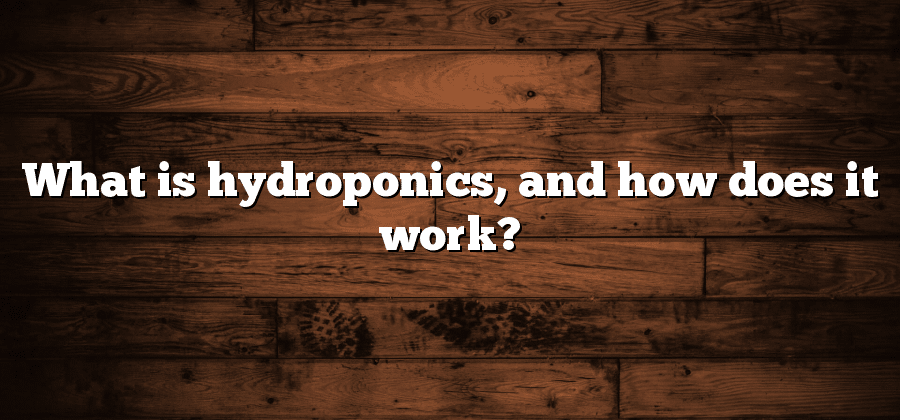History of Hydroponics
Hydroponics, the practice of growing plants without soil, has a history that dates back thousands of years. While the modern concept of hydroponics emerged in the 19th century, the idea of growing plants in water has been documented in ancient civilizations such as the Hanging Gardens of Babylon and the Aztecs’ floating gardens of Tenochtitlán. These early forms of hydroponics relied on natural processes without a thorough understanding of the science behind them. However, they sparked the curiosity and laid the foundation for future developments in this innovative approach to cultivation.
The formal experimentation and scientific exploration of hydroponics began in the 18th century with the work of various researchers. The botanist Julius von Sachs, known as the father of plant nutrition, conducted influential experiments in the 1850s. He discovered that plants could be grown in an inert medium and thrive solely on a nutrient-rich solution. This breakthrough paved the way for the systematic study and advancement of hydroponics. As knowledge and techniques continued to evolve, hydroponics gained importance in commercial agriculture, space exploration, and sustainable farming practices.
Advantages of Hydroponic Systems
Hydroponic systems offer numerous advantages over traditional soil-based gardening methods. Firstly, one of the most significant benefits of hydroponic systems is the ability to grow plants in a controlled environment. This allows for precise control over factors such as temperature, humidity, and lighting, ensuring optimal growing conditions. This controlled environment also minimizes the risk of pests and diseases, as well as reducing the need for harmful pesticides and herbicides.
Secondly, hydroponic systems are known for their efficient use of resources. Since the plants are grown in nutrient-rich water rather than soil, they require less water overall. In fact, studies have shown that hydroponic systems can use up to 90% less water than traditional soil-based gardening. Additionally, hydroponic systems can be set up in smaller spaces and have higher crop yield compared to conventional gardening methods. This makes hydroponics an ideal solution for urban areas or areas with limited land availability.
By taking advantage of the controlled environment and resource-efficient nature of hydroponic systems, growers can achieve higher crop yields while using less water and avoiding the use of harmful chemicals. This ultimately leads to a more sustainable and environmentally friendly method of growing plants.
Different Types of Hydroponic Systems
Hydroponic systems come in various forms, each designed to cater to different needs and requirements. One popular type is the deep water culture (DWC) system, which involves suspending plant roots in a nutrient-rich solution. This system is known for its simplicity and effectiveness, as the oxygenated solution provides ample nutrients directly to the plant roots.
Another commonly used hydroponic system is the nutrient film technique (NFT) system. In this system, a thin film of nutrient solution continuously flows over the plant roots, allowing for efficient nutrient uptake. The NFT system is particularly suitable for plants with small root systems or those that require minimal support.
Another type of hydroponic system used is the aeroponic system, which involves suspending plant roots in the air and misting them with a nutrient solution. This method provides excellent aeration and nutrient distribution, promoting rapid growth and increased yields.
Each type of hydroponic system has its own advantages and considerations, making it important for growers to carefully choose the system that best suits their needs and gardening style.
Essential Components of a Hydroponic System
A hydroponic system requires several essential components to operate effectively. One of the most crucial components is the grow tray or container, which holds the plants and their roots. These containers can be made from various materials, such as plastic or stainless steel, and are designed to provide adequate space and support for the plants. Additionally, the grow tray should be equipped with a drainage system to prevent waterlogging and ensure proper oxygenation of the roots.
Another essential component of a hydroponic system is the nutrient reservoir. This is where the nutrient solution necessary for the plants’ growth and development is stored. The reservoir should be well-designed to maintain the optimal pH and nutrient levels, which are essential for the plants to thrive. It is also important to regularly monitor and adjust the nutrient solution to ensure that it remains balanced and provides the necessary nutrients for the plants’ needs.
Nutrient Solution and its Role in Hydroponics
Hydroponics is a farming technique that involves growing plants without soil, using a nutrient-rich solution instead. The nutrient solution plays a crucial role in hydroponics, as it provides plants with all the necessary elements and compounds needed for their growth and development. This solution essentially acts as a substitute for the nutrients that would typically be obtained from soil in traditional farming methods.
The primary function of the nutrient solution is to supply plants with essential macronutrients, such as nitrogen, phosphorus, and potassium, as well as micronutrients like iron, zinc, and calcium. These nutrients are dissolved in water and delivered directly to the plant roots through various hydroponic systems. By providing a readily available source of nutrients, the solution ensures that plants can absorb them efficiently, resulting in faster growth rates and higher yields. Additionally, the nutrient solution in hydroponics allows growers to have precise control over nutrient levels, making it easier to adjust and optimize the growing conditions for different types of plants.






